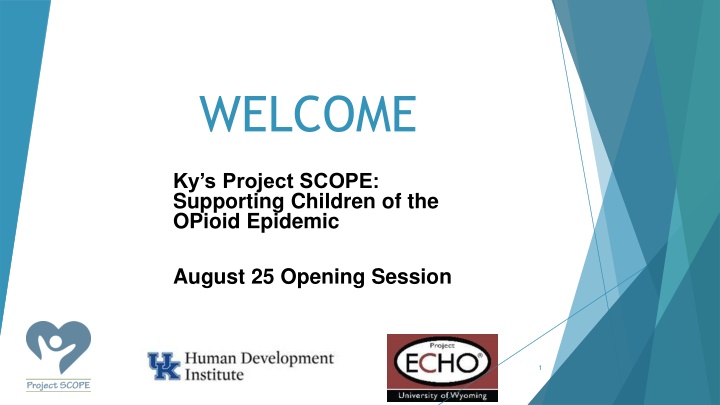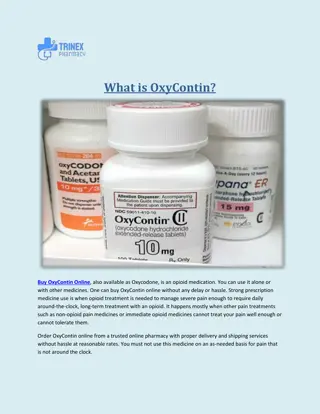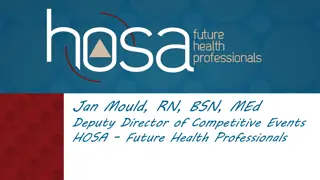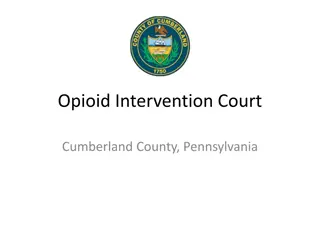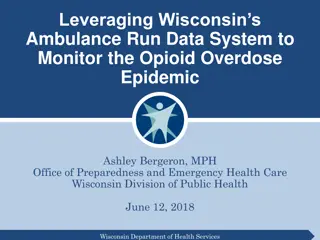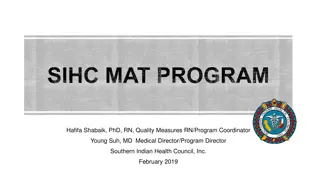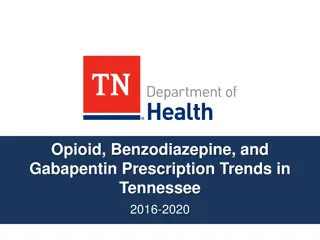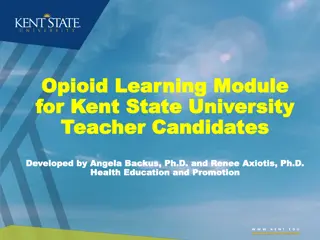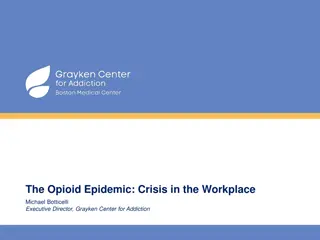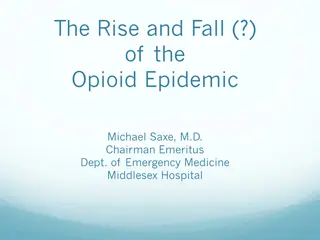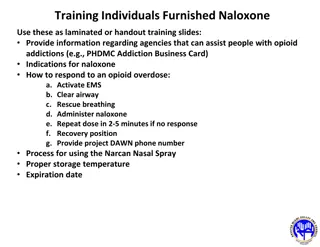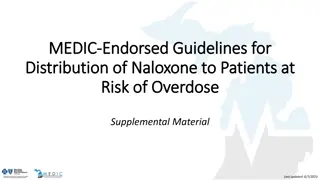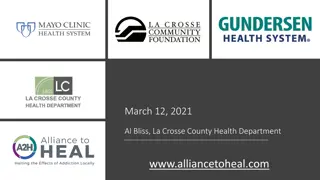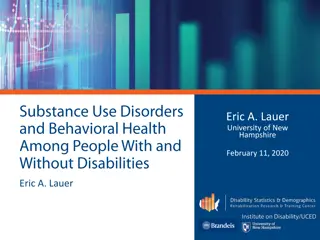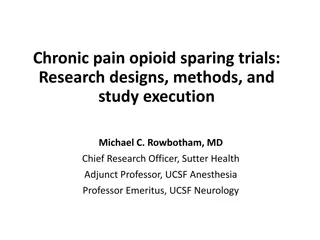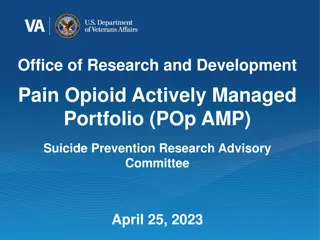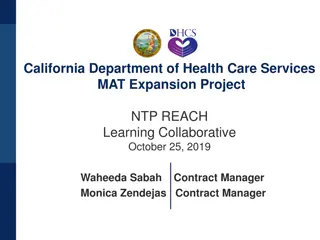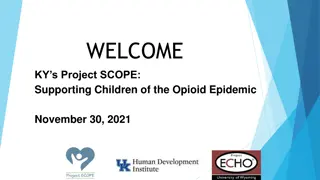Supporting Children of the Opioid Epidemic - Ky's Project SCOPE
Opening session on August 25 for supporting children affected by the opioid epidemic. The session includes introductions, thanks to team KY and partners, details on upcoming topics and speakers, series logistics, today's agenda, and small group facilitators. Join to learn about social determinants of health, addiction treatment, NAS, child development, trauma-informed interventions, and more.
Download Presentation

Please find below an Image/Link to download the presentation.
The content on the website is provided AS IS for your information and personal use only. It may not be sold, licensed, or shared on other websites without obtaining consent from the author.If you encounter any issues during the download, it is possible that the publisher has removed the file from their server.
You are allowed to download the files provided on this website for personal or commercial use, subject to the condition that they are used lawfully. All files are the property of their respective owners.
The content on the website is provided AS IS for your information and personal use only. It may not be sold, licensed, or shared on other websites without obtaining consent from the author.
E N D
Presentation Transcript
WELCOME Ky s Project SCOPE: Supporting Children of the OPioid Epidemic August 25 Opening Session 1
Introductions: Team KY and Partners Welcome from your KY Project SCOPE team! Kathy Sheppard-Jones, Caroline Gooden, Christine Hausman, Brandon Cannada, Emily Moseley Thanks to our supportive partners! Beth Jordan, Tena Robbins, Allen Brenzel, Miriam Silman, Koleen Slusher, Katie Marks, Brittany Barber, Maggie Schroeder and more from the Department for Behavioral Health Kristen Martin, Cabinet for Health and Family Services Jason Joy, PATHways and Holly Dye, Beyond Birth Paula Goff from First Steps, Department for Public Health Jill Seyfred, Janna Estep-Jordan, Olivia Thompson from Prevent Child Abuse KY Jenny Wurzback from Easter Seals Cardinal Hill Preschool Programs Amy Neal and Juanita Webb, Governor s Office of Early Childhood Participant introductions during breakout groups. Breakouts grouped geographically for networking. Project SCOPE administrative team joining today: Stephanie Weber, Canyon Hardesty, Tai Baker 3
Introductions: Topics and Speakers Tuesday, August 25 (Introduction to Social Determinants of Health, Dr. Mykal Leslie) Tuesday, September 8 (Addiction and Treatment, Sharon Hesseltine and Maggie Schroeder) Tuesday, September 22 (NAS, Diana Frankenburger) Tuesday, October 6 (Monitoring Child Development, Dr. Jennifer Grisham) Tuesday, October 20 (Having Difficult Conversations, Jason Joy) Tuesday, October 27 (Trauma-Informed Interventions for Families with Young Children, Miriam Silman) Tuesday, November 17 (The Role of Peers for Families in Recovery, Sharon Hesseltine and Kim Hillard) TIMES: 2PM 3:30 PM EASTERN EACH DATE 4
Today's Agenda 2:00-2:30 pm Introductions and procedures 2:30-3:00 pm Social Determinants of Health (Dr. Leslie) 3:00-3:15 pm Small group breakout sessions for introductions 3:10-3:28 pm Reconvene large group; questions 3:28-3:30 pm Session closure and evaluation reminder 6
Introductions: Small Group Facilitators and Co-facilitators Thanks to our facilitators and co-facilitators! Sharon Hesseltine with Joy Varney Kate Dean with Bethany Wilson Karen Cottengim with Marie Vice Caroline Gooden with Amanda Metcalf Christine Hausman with Suzanne Ross Emily Moseley with Barb Greene Tonya Jernigan 7
Introductions: Participants Thanks to our participants! You will introduce yourselves and meet your colleagues during the breakout sessions. It truly takes a village to address the opioid epidemic in KY. This training series would not be possible without each one of you! 8
Rename Your Zoom Profile Please rename your profile to your first and last name, and the agency/organization you represent. Click the Participants icon on the bottom menu of the Zoom window. Click on your profile. Rename your profile in the dialogue box. EXAMPLE: Jose Tovar, Dept for Behavioral Health JoAnna Brock, Early Childcare Center 10
How to Raise Your Hand The Raise Hand feature is helpful if you have a question for the facilitator. To use this feature, run your mouse on the Zoom window to locate the menu at the bottom. Select Participants to open the Participant window. On the Participant window, click the Raise Hand option at the bottom. You may also enter questions and comments in the chat 11
Resource Materials All session materials available at https://www.hdilearning.org/project-scope-echo-series/ Materials include speaker PowerPoints, case presentation template, resource materials Please contact brandon.cannada@uky.edu if you need assistance with technology 12
For Participants Attend all sessions ready to learn and to share Review Participant Guide for suggestions and procedures Complete pre-series survey before your first session Complete post-session evaluations each session Complete post-series evaluation after November 17 Submit case studies for discussion; see case presentation form and case presentation PPT template on resource page Select incentive after attendance at all sessions (choice of 1 of 4 books) 15
Case Presentations Solicited from participants; please submit for next week! Brief presentation immediately after each speaker Opportunity to problem solve with peers Reinforce strategies Focus on current issue or problem of practice Stories of success Forms available at https://www.hdilearning.org/project- scope-echo-series/ 16
Team KY SCOPE Case Study Form (required; see resource folder for full form) Select the topics for which your case could be a good match (select all that apply) _____Tuesday, September 8: Addiction and Treatment _____Tuesday, September 22: NAS _____Tuesday, October 6: Monitoring Child Development _____Tuesday, October 20: Having Difficult Conversations _____Tuesday, October 27: Trauma-Informed Interventions for Families with Young Children _____Tuesday, November 17: The Role of Peers for Families in Recovery Please provide the following case information, with all identifying information removed. What is the current age of the individual? What is the current status of the individual? In what program are they enrolled? Please identify the primary concern and goal for this case presentation. Describe contributing factors that may have kept the individual from progressing. What are common triggers, stressors, and/or factors related to your concern? 17
KY PPT Template for Case Presenters (optional; see resource folder for full PPT) 18
Take Care of Yourself We will be addressing content that may be upsetting: Discussion of some topics may influence you more deeply or personally; may trigger a personal trauma response Take mental breaks as needed Be sensitive to others who may be struggling during discussions 19
Please Protect Confidentiality When sharing about another person Avoid using their real first, middle, or last name or any initials. Do not identify an individual s familymembers, friends,co-workers,email addresses,etc. De-identify examples and situations Reach out to a UK team member if you are unsure what to share. 20
Session Schedule Starting Sept 8 2:00pm-2:10pm Zoom Call procedures and introductions 2:10pm-2:40pm Expert presentation on topic 2:45pm-2:50pm De-identified case study presentation on case related to topic (participants please send suggested cases of yours; presentation form and PPT included in resource site) 20:50pm-3:10pm Small group breakout sessions to discuss strategies 3:10pm-3:28pm Reconvene large group and share strategies 3:28pm-3:30 Session evaluation reminder; closing 21
ECHO SCOPE procedures, credits, incentives 22
Important Considerations SCOPE ECHO sessions are an interactive learning community Please turn on your video, and have your microphone available for breakout groups 23
Recording and Close Captioning We are recording this SCOPE session for educational and quality improvement purposes. By participating in this session, you are consenting to be recorded. If you do not wish to be recorded, please disconnect from the session. We are providing captioning for each session; click on the CC icon and the captioning will appear. 24
Participation SCOPE ECHO is an interactive community: presenters, partners, and participants communicate and support each other during sessions. All learn, all share. Participants will be engaged in asking questions after the presentation and providing feedback for the case study. Case studies are the best way to solidify skills learned in presentations and receive directly applicable strategies. If you haven t sent a case study, please consider doing so! 25
Getting Credit For Attendance Professional development credits available by applying to your own professional boards To receive credit for the series from SCOPE: Fill out pre-series materials and evaluation sent to you after each session Certificates of Completion available at end of series; Incentives provided! Credit available through ECE-TRIS 26
Social Determinants of Health Mykal Leslie, PhD, LPCC, CRC; Kent State 27
The Opioid Crisis and Social Determinants of Health Project SCOPE Mykal Leslie, PhD, LPCC, CRC
History and Current State of Opioid Epidemic Social Determinants of Opioid Use Disorder Impact of COVID Impact of Opioid Epidemic on Kentucky Families Overview of Session
The U.S. is in the midst of an opioid epidemic with the misuse of and addiction to opioids becoming a serious national crisis that affects public health as well as social and economic welfare1 Opioids include prescription pain relievers, heroin, and synthetic opioids such as fentanyl Opioid Epidemic Overview Drug overdose is leading cause of accidental death in U.S with opioids being the most common2 Since 1999, opioids have been responsible for more than 630,000 deaths in the US It is estimated between 8-12 percent of those who use any type of opioid develop an OUD3 The estimated economic costs of opioids have exceeded $500 billion4
First Wave: Prescription Pain Killers5 Strong marketing efforts for opioid prescriptions in the 1990s Low risk benefits for drugs Such as sustained release opioid, OxyContin OxyContin prescriptions went from 670,000 in 1997 to 6.2 million in 2002 Rise of pill mills in areas hit hard by poverty and unemployment Collapses of the coal and manufacturing industries Ohio Valley, Appalachia, Maine, and Alabama had rates of OxyContin abuse 5-6x national average Black tar heroin arose in San Fernando Valley of California spreading eastward Targeted younger people in smaller sized cities Three Phases of the Opioid Epidemic
Second Wave: Heroin Overdose Deaths5 Began in 2010 Marked by rapid increases in heroin overdose deaths Tripled between 2010 and 2015 Three Phases of the Opioid Epidemic Peak of opioid prescriptions in 2011 at 206 million Subsequent crackdown on prescription policies and pill mills reducing access to prescription opioids Heroin was a much more affordable and available alternative
Phase Three: Synthetic Opioid Overdose Deaths5 Began in 2013 Tied to significant increases in overdose deaths due to synthetic opioids Illicitly-manufactured fentanyl (IMF) Deaths attributed to IMF increased nationally by 540% from 2013-2016 In 2016, synthetic opioids were the leading cause of opioid overdose deaths (19,413) Followed by deaths attributed to prescription opioids (17,087) And finally death attributed to heroin (15,469) People presenting for treatment now are more likely to have began opioid use with heroin, rather than prescription opioids6 Three Phases of the Opioid Epidemic
In 2018, an estimated 1.7 million people in the United States suffered from substance use disorders related to prescription opioid pain relievers, and 526,000 suffered from a heroin use disorder (not mutually exclusive)1 46,802 Americans died as a result of an opioid overdose, including prescription opioids, heroin, and illicitly manufactured fentanyl, a powerful synthetic opioid 128 people in the United States die after overdosing on opioids every day Current State of the Opioid Epidemic 989 opioid related overdose deaths in Kentucky in 20187 23.4 deaths per 100,000 people Decrease from the 1,160 (27.9) in 2017 National average is 14.6 In the top 10 states in opioid prescription rates7 79.5 opioid prescriptions for every 100 persons This is a 42% DECREASE from 2011 (137 rx per 100 persons)
Reciprocal impact of social determinants5 Determinants increase risk of developing an OUD Often the same determinants also increase adverse outcomes from OUD Relapse Related secondary health conditions Social Health Determinants of Opioid Use Disorders Increase systemic impact of OUD5 Neonatal Abstinence Syndrome (NAS) Children and partner health outcomes
Economic hardship and high rates of unemployment consistently characterize vastly different communities hit hard by the opioid crisis such as Appalachia and urban centers in the United States10 Areas that often have poor access to childcare Social determinants contribute to hopelessness and social trauma that set the stage for opioid abuse and dependency10 Social conditions such as homelessness or high exposure to violence can shape health behaviors by increasing opportunities and perceived reasons for engaging in high risk behavior Low educational attainment, low income, and low employment success produces poor social networks, low levels of power, prestige and self-mastery that contribute to illicit drug use10 Economic Stability and Education
Social factors contribute to health disparities directly by affecting the availability of resources and access to social support systems in ways that increase marginalization and decrease compliance with treatment and medication10 Increases in prescription opioid abuse have disproportionately affected rural communities, whereas heroin and cocaine use centers more on urban areas11 Social and Community Context The average per capita income for Kentucky residents in 2018 was $42,458, although rural per capita income lagged at $35,28812 The poverty rate in rural Kentucky is 21.1%, compared with 13.7% in urban areas of the state12 19.3% of the rural population has not completed high school, while 10.7% of the urban population lacks a high school diploma12 The unemployment rate in rural Kentucky is 5.1%, while in urban Kentucky, it is 3.9%12
Barriers and limitations of treatment systems that concern families of individuals struggling with SUD include13 Lack of quick and easy access to treatment for SUD Barriers to medication-assisted treatment (MAT) for opioid addiction Limited professional care to support long- term recovery after a rehabilitation program Limits to funding to pay for certain types of treatment Limited or lack of services for families when their loved one is in treatment or refuses treatment Healthcare and Treatment 81.9% of Kentuckians with drug dependence or abuse go untreated14
Increase social and economic stress15 Disrupted access to healthcare16 Particularly for those in rural and urban communities Impact of COVID-19 on Social Determinants? Increase in isolation, meaning less social support and fewer opportunities to engage in health maintenance behaviors16 Increase in financial stress15 Disruption of educational opportunities Significant disruption in employment opportunities 15
8.7 million children nationwide have a parent who suffers from a substance use disorder14 In 31% of the 5,686 Kentucky foster care placements in 2016, parental substance use was a factor14 Adverse effects are greater when both parents have an SUD, as these disorders14 Traumatic events resulting from parental substance use can cause lifelong challenges for children lasting into adulthood14 Education attainment issues Increase in risky behaviors such as alcohol and drug use Increase chance of health conditions such as obesity and heart disease Impact on Kentucky Children
Children of parents with SUDs are at increased risk for: Abuse or neglect, leading to involvement in the child welfare system; Physical health problems Social skill deficits Emotional or psychiatric problems such as anxiety, depression, or low self- esteem Behavioral problems such as oppositional behaviors Academic problems such as lower grade point averages, increased grade retention, or failure to pursue secondary education13 Impact on Kentucky Children
Neonatal Abstinence Syndrome (NAS)/Neonatal Opioid Withdrawal Syndrome (NOWS) In 2018, the rate of NAS/NOWS in Kentucky was 26.3 cases per 1,000 hospital births (national average ~7 cases per 1,000 births)7 Prenatal exposure to opioids can lead to lower birthweights, respiratory conditions, feeding difficulties, seizures, and longer hospital stays14 Higher rates of NAS seem to be associated in areas where there are shortages in mental health professionals17 Higher long-term unemployment rates were associated with higher rates of NAS17 A higher proportion of manufacturing jobs in rural counties was associated with higher rates of NAS, which is consistent with prior research finding higher opioid use in counties with more manufacturing17 Neonatal Abstinence Syndrome (NAS)
Interventions targeting social determinants are both preventative and necessary for effective individual and family recovery Interventions must be targeted across the lifespan for families impacted by the opioid epidemic COVID-19 may exacerbate impact of opioid crisis and could negate recent improvements seen in opioid use and overdose deaths Conclusion
Breakout Group Introductions After the next slide, Brandon will move you into your breakout groups; please be patient and click to accept the breakout room. After about 10 minutes, the room will close and you ll reenter the large group. ? 46
Breakout Questions for August 25 WRITE THESE QUESTIONS BEFORE THE BREAKOUT BEGINS 1) What experience have you had with children with NAS and their families? 2) What is your goal in attending these sessions? 3) What is one little known fact about you that you are willing to share? YOU WILL BE BROUGHT BACK TO THE LARGE GROUP AFTER 10 MINUTES 47
Evaluation Procedures For participants: pre-series survey; evaluations after each session and after the series Incentives: drawing after each session; book selection for all participants who attend all sessions; certificate of attendance for attendance at sessions indicated 49
Questions? Contact us with any questions: Content and case presentations: caroline.gooden@uky.edu; christine.hausman@uky.edu Technology: brandon.cannada@uky.edu Evaluation and case presentations: emily.moseley@uky.edu See you next session, September 8 at 2pm! Sharon Hesseltine and Maggie Schroeder, Addiction and Treatment 50
